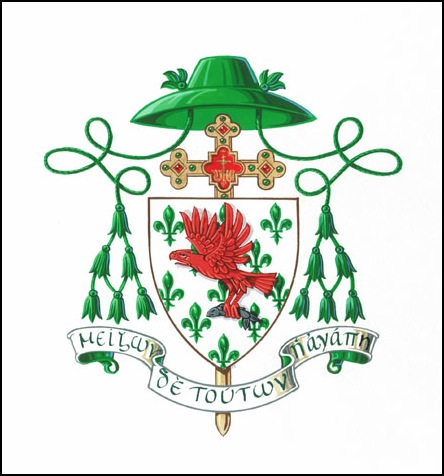The Arms of the Reverend Monsignor Vernon Gardin, Ph.D.
One of the most admired and beloved Catholic priests in St. Louis is the Reverend Monsignor Vernon Gardin, formerly Vicar General of the Archdiocese. It was once the hope of many of his friends that he would be made a bishop, and Ragen was asked to design arms for the monsignor so as to have them ready if the appointment were made.
The first design was based on the Trinacria, the symbol of Sicily. In that symbol, a triskele (three legs conjoined) is charged with the face of Medusa. As is the case in the arms of the Isle of Man, the triskele alludes to the triangular shape of the island, while Medusa’s head represents the powerful and dangerous Mt. Etna. The triskele alone seemed enough to mark Gardin’s Sicilian heritage—and a deadly female from mythology seemed out of place in a cleric’s arms. A field argent semy-de-lys was a reference both to Gardin’s home in St. Louis (the lilies from the arms of St. Louis the King) and to his name (many flowers make a garden). With the triskele in gules, the arms also alluded to the red, white, and green of the Italian flag.

The Arms of Gardin (Ancient) with the insignia of a Prelate of Honor to his Holiness and the Decoration a knight of the Holy Sepulchre.
Blazon: Argent semy-de-lys Vert Three Legs Conjoined Gules.
As depicted by Andrew Stewart-Jamieson.
The Arms of Gardin with the insignia of a Bishop
As depicted by Andrew Stewart-Jamieson
Sadly, these arms caused something of a scandal among Monsignor Gardin’s family and parishioners, who evidently had a somewhat Victorian objection to the display of even a bit of leg. Ragen designed a new version, which replaced the triskele with an eagle volant clutching a fish in its claws on the same semi-de-lys background. The eagle in flight is an allusion to the arms of Palermo; that it is flying westward while clutching a fish represents the Italian immigrant experience, since Italians carried into the diaspora both their faith and their cuisine, and the fish can be seen either as an IXTHUS or an ingredient.

The Arms of Gardin (Modern) with the Insignia of a Bishop
As Depicted by Andrew Stewart-Jamieson
The Arms of the Shrine of Our Lady of Guadalupe, La Crosse, Wisconsin
Another Catholic cleric beloved in St. Louis is His Eminence Raymond Leo, Cardinal Burke, who served all too briefly as the city’s archbishop. While still bishop of La Crosse, Wisconsin he founded a shrine dedicated to Our Lady of Guadalupe. Ragen was asked to design arms for the shrine, and he was present at the shrine’s dedication in 2009.
Devotion to Our Lady of Guadalupe is, of course, based on the story of her apparition to a native peasant, Juan Diego, in the years after the Spanish Conquest of Mexico. The Virgin instructed Juan Diego to tell the Spanish Bishop that she had appeared, but the bishop refused to believe him. At last, on a winter’s day so cold that there was snow on the ground, the Virgin appeared to the poor Indian again. She told him to return to the bishop, but that first he should gather some roses he would find blooming nearby despite the season. Juan Diego did as he was bid, finding the roses and wrapping them in his tilma or cloak. When he presented the roses to the bishop, all were first amazed by the out-of-season roses, and then astounded by the miraculous image they found on the inside of the cloak: Our Lady herself, but appearing not as a fair-skinned European, but with the dark complexion and hair of an indio. (Archbishop Burke points out that during her earthly life, Mary of Nazareth probably had coloring more like that of modern Mexicans and Palestinians than like that of the European ladies who have embodied her in much religious art.) This apparition, in which Mary showed herself as one of them, was the turning point in the conversion of the indigenous population to Christianity.
The arms devised for her newest shrine are quite simple:

The Arms of the Shrine of Our Lady of Guadalupe
La Crosse, Wisconsin
as Depicted by Andrew Stewart-Jamieson
The blazon is Tierced in Chape Argent and Vert a bunch of roses Gules slipped and slipped proper. The division of the field is one that has often been used to recall an open cape, in arms related to the Dominican order, for example. Here it becomes Juan Diego’s tilma, which has been filled with Our Lady’s roses. (That there are four roses in a cruciform pattern in the illustration of the arms was the artistic choice of Andrew Stewart-Jamieson, the distinguished heraldic artist who painted them.)
The design was given the American Heraldry Society’s Award for Best Heraldic Design of 2009.